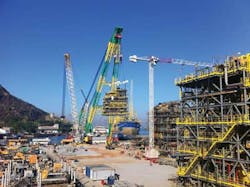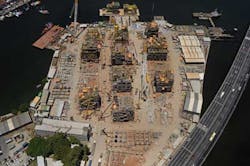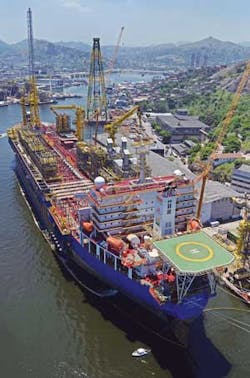Petrobras FPSOs queue up at SBM's new Brasa yard
Doug Gray
Contributing Editor
Just across the Guanabara Bay from Rio de Janeiro and the global headquarters of Petrobras, SBM's Brasa shipyard in Niteroi is completing its first project since opening in July 2012, theFPSOCidade de Ilhabela. The remarkably urban location of the country's only fully dedicated FPSO yard brings advantages as well as obstacles. But the ongoing construction of the site itself appears to be giving SBM a strong foothold in Brazil, as Petrobras pushes to keep oil production levels on target.
Developed in partnership with Brazil's Synergy group, the Brasa yard is entirely dedicated to SBM's activities, which currently include the completion of three FPSO conversions by the beginning of 2016:Cidade de Ilhabela, Cidade de Maricá, and Cidade de Saquarema. The first, a single-hull vessel destined for the presalt BM-S-9 block in the Sapinhoá field of the Santos basin, arrived in late December 2013, and docked on Jan. 12, 2014. It will eventually join the FPSO Cidade de São Paulo at Sapinhoá, which began production in January 2013. Petrobras operates the field on behalf of partners BG and Repsol.
Cidade de Ilhabela is SBM's largest FPSO to date, with a topside weighing 23,000 metric tons, around 6,000 more than its previous biggest, Cidade de Paraty. The converted VLCC will have a production capacity of 150,000 b/d of oil and storage capacity of 1.6 MMbbl. According to Production Manager Christophe Rousseau, that is about as far as these types of hulls can go. "The ship size has been staying the same but the topsides are getting higher and more compact. We are now close to the limit of capacity for these third-generation FPSOs," he said.
Short delays with the first docking aside, the schedule at Brasa has been remarkably smooth following the original build and integration in China, helped by the acquisition of the Pelicano 1 crane. "BeforeParaty, we did not have a lifting solution. Now we have our Pelicano, and can define exactly when we lift, and control the whole job more easily," says Philippe Levy, SBM Brazil director. "We are trying to support Petrobras, and they are trying to maximize their production, so we have to build to capacity."
The specific demands of working at the high pressures found in the Santos basin and the treatment of its contaminants, as well as stringent new environmental inspections, have contributed to the need for these more complex topsides. Ten modules are being built and lifted at Brasa, including the highly specialized oil processing, CO2 compression, and reinjection modules, leaving the larger, more space-demanding components like the 120-m (394-ft) flare tower to be fitted in China. Not that the modules in Brazil are small; the 2,000-metric ton CO2 injection model had to be lifted in three parts, due to the limits of the crane.
Displaying 1/2 Page 1,2Next>
View Article as Single page



